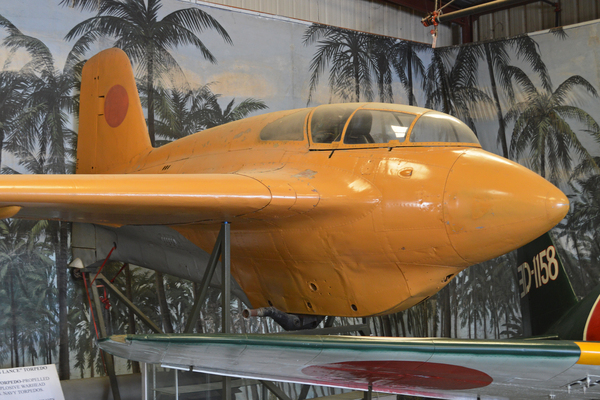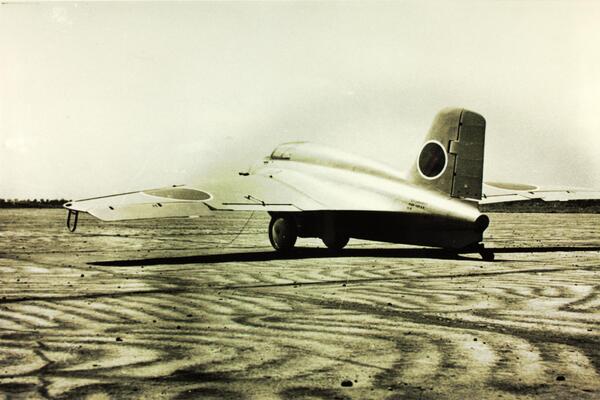

三菱 秋水 Mitsubishi J8M Shusui
A Detailed Overview
The Mitsubishi J8M Shusui, meaning "Autumn Water," was Japan’s ambitious attempt to develop a rocket-powered interceptor during World War II. Inspired by the German Messerschmitt Me 163 Komet, the Shusui was designed to defend Japan from devastating Allied bombing campaigns. Although its development was fraught with challenges, the Shusui stands as a testament to Japan's innovative spirit and determination in the face of overwhelming odds. Let’s explore its history, design, and legacy.
Development and Design The J8M Shusui was born out of Japan's collaboration with Germany during the war. After receiving blueprints and technical information for the Me 163, Japanese engineers began adapting the design to suit local production capabilities and available materials. Key Features - Rocket Propulsion: Powered by the Toku Ro.2 rocket engine, a domestic version of the German Walter HWK 509A, the Shusui aimed for rapid climbs and extreme speeds. - Sleek Aerodynamics: The Shusui featured a swept-wing design for stability and performance at high speeds. - Compact Design: Its small size and light weight made it highly maneuverable, ideal for intercepting Allied bombers.
Armament The Shusui was planned to be equipped with: - Two 30mm Type 5 cannons in the nose, providing significant firepower to damage or destroy heavy bombers with a single pass. Engine The Toku Ro.2 rocket engine produced an impressive 1,500 kilograms of thrust, enabling the Shusui to climb rapidly to bomber altitudes. However, its burn time was limited to only a few minutes, requiring precise timing and piloting skill during combat.
Operational History The Shusui was developed during the final stages of World War II, leaving little time for testing and refinement. Its operational history is limited due to production delays and resource shortages. First Flight The prototype, designated J8M1, conducted its maiden powered flight on July 7, 1945. Tragically, the flight ended in disaster when the engine failed shortly after takeoff, causing the aircraft to crash. This setback, combined with Japan’s surrender a month later, meant the Shusui never entered operational service. Planned Role The Shusui was intended to intercept high-altitude bombers, such as the Boeing B-29 Superfortress, which were causing widespread devastation across Japan. Its incredible speed and climb rate made it well-suited for this role, though its limited flight duration posed significant tactical challenges.
Strengths and Weaknesses Strengths - Extreme Speed: The rocket engine enabled unparalleled speeds, making it difficult for bombers or escorts to evade or intercept. - Rapid Climb Rate: The Shusui could reach high altitudes quickly, a critical advantage against bombing raids. - Compact Design: Its small size made it harder to detect and target. Weaknesses - Short Flight Time: The rocket engine’s limited burn time drastically reduced operational flexibility. - Reliability Issues: The engine and fuel system were prone to failure, as demonstrated during its test flight. - Resource Constraints: Japan lacked the materials and infrastructure to mass-produce the Shusui.
Legacy The Mitsubishi J8M Shusui represents one of the most ambitious aeronautical projects undertaken by Japan during World War II. Although it never achieved operational status, the Shusui symbolizes the innovative approaches explored by nations during the war’s technological race.
Influence on Aviation The Shusui highlighted the potential of rocket-powered flight, paving the way for post-war research into high-speed and high-altitude aviation. While it was ultimately a wartime necessity, its design concepts influenced future interceptor development. Cultural Significance As one of the rare rocket-powered aircraft of the war, the Shusui remains a fascinating subject for aviation enthusiasts and historians. Its story serves as a reminder of the lengths to which nations went to innovate under immense pressure. Surviving Aircraft Today, several Shusui prototypes and replicas exist in museums, including the National Museum of Nature and Science in Tokyo. These exhibits offer a glimpse into the extraordinary challenges and ingenuity of wartime aviation.
Conclusion The Mitsubishi J8M Shusui was a bold and innovative attempt to counter the overwhelming air superiority of Allied forces in the final stages of World War II. Despite its limited success, the Shusui remains a symbol of the rapid technological advancements made during the conflict and Japan’s determination to defend its homeland. Its legacy endures as a remarkable chapter in the history of experimental aviation.